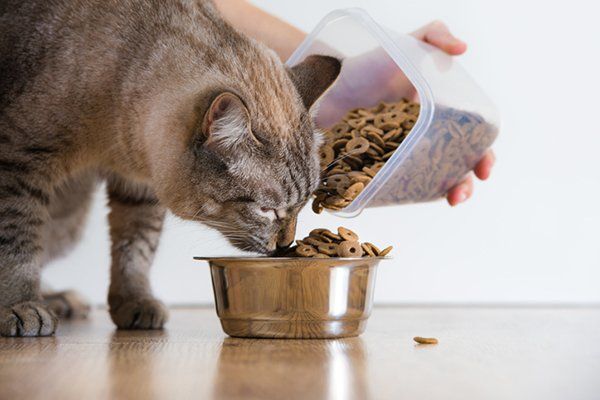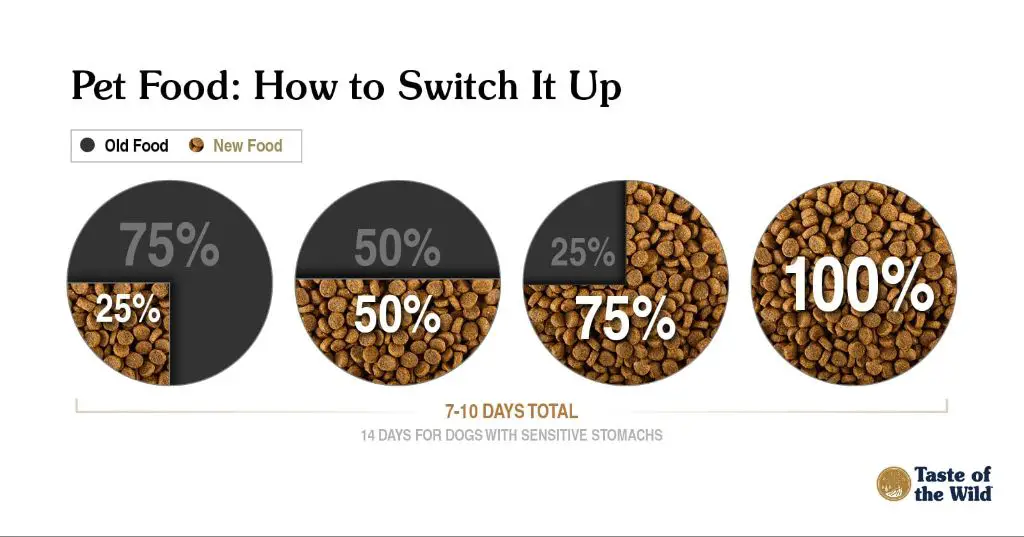Many cat owners wonder if it’s okay to feed their feline companion dog food, especially if it’s a reputable brand they already buy for their canine. While dogs and cats share some nutritional needs, their dietary requirements differ in important ways. Feeding the wrong pet food can potentially lead to nutrient deficiencies or imbalances in cats over time. Understanding the key differences between dog and cat foods allows owners to make informed choices about what to feed their furry friends.
This article explores the pros and cons, as well as appropriate amounts and cautions, around cats eating dog food. With insight from veterinary nutritionists and health experts, we provide pet owners the facts to decide if and how to incorporate dog food into their cat’s diet.
Background on Rachael Ray’s Dog Foods
Rachael Ray Nutrish is a popular brand of dog food owned by celebrity chef Rachael Ray. It was launched in 2008 with the goal of providing high-quality, natural ingredients to dogs at an affordable price point.
Rachael Ray Nutrish dog foods feature simple, easy-to-pronounce ingredient lists without artificial preservatives, flavors or colors. Most recipes are grain-free and contain premium proteins like real chicken, beef or salmon as the first ingredient (Source). They offer nutritionally balanced formulas for puppies, adults and seniors.
According to reviews, pet owners appreciate the quality ingredients and reasonable prices of Rachael Ray Nutrish recipes. The food is well-received by most dogs and supported by many veterinarians. The brand has a reputation for producing tasty, natural and nutrient-rich dog food.

Key Differences Between Cat and Dog Foods
There are some important differences in the nutritional requirements for cats versus dogs that lead to differences in cat and dog food formulas. As obligate carnivores, cats have a higher protein requirement than dogs to support metabolism and organ function. According to veterinary nutritionists, cats require at least 26% protein in their diet, whereas adult dogs only require around 18% protein (1). Cats also cannot synthesize some key amino acids like taurine on their own, so cat foods are supplemented with added taurine while dog foods do not contain added taurine (2).
Additionally, cats need more fat and calories in their diet than dogs. Cat foods have higher fat percentages, around 9-15% versus 5-8% for dog foods. The added fat provides concentrated energy for cats. Cats also utilize fat and protein more efficiently than dogs due to differences in their metabolism. Since cats evolved as desert animals, their bodies are adapted to get moisture from food rather than drinks. Therefore, cat foods have more moisture than dry dog kibbles (3).
These differences mean that cat food formulated specifically for feline nutrition provides the right balance of nutrients, while dog food does not. Feeding a dog food long-term can potentially lead to malnutrition or deficiencies in cats.
Sources:
(1) https://www.petfoodinstitute.org/blog/cats-vs-dogs-5-differences-nutritional-needs/
(2) https://www.meowmix.com/cat-care/difference-between-dog-and-cat-food
(3) https://www.pawcbd.com/blogs/posts/cat-food-vs-dog-food-how-they-are-different
Potential Risks of Feeding Cat Rachael Ray Dog Food
While Rachael Ray’s dog foods are nutritionally balanced for dogs, they may pose some risks for cats.

One potential risk is nutritional deficiencies. According to Dutch, dog foods do not contain adequate levels of key nutrients cats require like protein, fat, and vitamins. Feeding a cat dog food long-term can lead to deficiencies in important nutrients.
Another risk is digestive issues. Dog food has higher mineral contents than cat food. The higher mineral content, especially calcium and magnesium, may give some cats loose stools or diarrhea. The richer fat content in dog food may also upset some cats’ digestive systems.
A third potential risk is weight gain. Dog foods have higher caloric density than cat foods. Feeding cat Rachael Ray dog food can easily cause a cat to gain excess weight, putting them at risk of obesity.
Overall, while most cats may tolerate dog food short-term, it is best to feed cats a cat-specific food formulated to meet their nutritional needs long-term.
Benefits of Feeding Cat Rachael Ray Dog Food
There are some potential benefits to feeding a cat Rachael Ray dog food in certain circumstances:
Convenience – If you have both cats and dogs, it can be more convenient to only purchase and feed one type of pet food. This avoids having multiple bags open and saves extra trips to the pet store.
Budget Friendly – Rachael Ray dog food formulas are typically more affordable than specialty cat foods. For cat owners on a tight budget, using an inexpensive dog kibble can help reduce pet food costs.
Picky Eaters – Some cats are extremely picky about food textures and flavors. A dog kibble with a unique shape or recipe can entice finicky felines to eat. Rachael Ray dog foods contain savory ingredients that cats enjoy.
Sources:
http://muh5s3sm.coldcdn.net/
http://muh5s3sm.coldcdn.net/
How Much Rachael Ray Dog Food Can Cats Eat?
While an occasional treat of Rachael Ray dog food is unlikely to harm a cat, it is not recommended as a steady part of a cat’s diet. There are some key differences in the nutritional needs of cats versus dogs that make dog food unsuitable as a regular meal for cats.
Cats are obligate carnivores, meaning they need a high level of animal-based proteins and fat in their diet, while dogs are omnivores and can get nutrition from plants as well. Rachael Ray dog foods contain plant-based proteins and fillers like corn, wheat, and soy that would not provide complete nutrition for cats.
The Association of American Feed Control Officials sets nutritional standards for both cat and dog foods. Cat foods must contain a minimum of 26% protein and 9% fat, while dog foods only need 18% protein and 5% fat minimums. Rachael Ray dog food would not meet a cat’s higher protein needs.
While the occasional piece of dog food won’t harm a cat, feeding it regularly or exclusively could lead to malnutrition and health problems over time. Cats have specific nutritional requirements best met by a high-quality cat food formula.
Tips for Transitioning Cats to Dog Food
Transitioning cats to dog food should be done slowly over the course of days or weeks to allow their digestive system to adjust. According to the Aaha.org guidelines, when changing foods, start by replacing only 25% of the cat’s current food with the new dog food on the first day [1]. Incrementally increase the ratio of new to old food over the next 5-7 days until the cat is eating 100% new dog food.

Make sure to watch for any signs of digestive upset like vomiting, diarrhea, or decreased appetite during the transition. Reduce the amount of new food and extend the transition period if the cat experiences any stomach upset. Providing supplemental digestive enzymes or probiotics can also help support healthy digestion.
Additionally, since dog foods tend to be lower in taurine than cat foods, consider supplementing with additional taurine while feeding the dog food. Taurine deficiency can cause heart and eye problems in cats over time [2]. Monitoring the cat’s behavior and energy levels can help determine if taurine supplementation may be warranted.
[1] https://www.aaha.org/globalassets/05-pet-health-resources/nutritionalresources/petparent/aaha-tips-and-timelines.pdf
[2] https://be.chewy.com/transitioning-your-pet-to-a-new-food-tips-to-ensure-success/
Signs of Illness from Unsuitable Dog Food
Feeding dog food to cats that isn’t specifically formulated for feline health can lead to several concerning symptoms over time. Here are some of the most common signs of illness from unsuitable dog food in cats:
Vomiting and Diarrhea
One of the first and most obvious symptoms will be vomiting and/or diarrhea, usually within hours of eating the dog food. Cats may vomit repeatedly after eating dog food that disagrees with them. Diarrhea containing blood, mucus, or undigested food may also occur. These are signs the cat’s digestive system is struggling with ingredients meant for dogs.
Constipation
On the other hand, some cats may become constipated from dog food that is too high in fiber or other ingredients their bodies aren’t adapted to processing. Straining to defecate without producing feces is a sign of constipation.
Weight Loss or Gain
The improper balance of nutrients, calories, and protein in dog food can lead some cats to lose or gain weight. Weight loss usually stems from gastrointestinal issues that prevent proper absorption of nutrition. Weight gain results from excess carbs and fillers compared to a cat’s actual needs.
Lethargy and Weakness
Illness from unsuitable dog food can cause cats to become depressed, fatigued, weak, and generally unwell. They may stop playing, sleep more often, and have difficulty jumping up or walking normally. These nonspecific symptoms warrant an exam by a veterinarian.
If a cat shows any concerning symptoms after eating dog food, even just once, it’s important to switch them back to an appropriate diet formulated for cats and contact a vet if the issues persist. Long-term diet-related illnesses can be serious but avoiding dog food can prevent most problems.
Alternatives to Feeding Cat Dog Food

If you don’t have cat food available, there are some healthy alternatives you can feed your cat instead of dog food:
High-Protein Cat Foods
Cats are obligate carnivores and require a high-protein diet. Look for commercially available wet or dry cat foods that contain at least 30% protein from quality animal sources like chicken, turkey, salmon or tuna.
Wellness Core (https://www.wellnesspetfood.com/our-brands/core) and Taste of the Wild (https://www.tasteofthewildpetfood.com/cat-formulas/) are good high-protein cat food brands.
Raw Diet
Feeding raw meat is the most natural diet for cats and provides optimal nutrition. Make sure any raw meat is fresh and comes from reputable sources. Raw diets should include muscle meat, organ meat, edible bone and supplements.
Homemade Cat Food Recipes
With vet supervision, you can make nutritionally balanced homemade cat food. Look for recipes that contain animal protein, healthy fats, vitamins and minerals. Avoid recipes with garlic, onions or excessive vegetables.
Examples of homemade options include cooked chicken, turkey or beef, tuna packed in water, sardines, and boiled, mashed potatoes or sweet potatoes.
Conclusion
In summary, while Rachael Ray’s dog foods are nutritionally balanced for dogs, they may not be ideal for cats. Cats have different nutritional needs than dogs, requiring higher levels of protein, fat and certain vitamins and minerals. Feeding a cat dog food long-term could result in nutrient deficiencies and health issues over time.
That said, small amounts of Rachael Ray dog food are unlikely to harm an otherwise healthy cat in the short term. Dog food can be fed as an occasional snack or as part of a rotational diet under veterinary guidance. Cats tend to find dog food more palatable as well.
When transitioning a cat to dog food, do so slowly by mixing in small amounts with their regular cat food. Watch for signs of digestive upset or rejection of the new food. For picky eaters or cats with allergies, a premium dog food like Rachael Ray Nutrish may be more appetizing and tolerated than typical cat foods. Consult your veterinarian for advice tailored to your individual cat.
Ultimately, it’s best to feed cats a high-quality food formulated for their nutritional needs. But Rachael Ray’s dog food can be fed as an occasional treat in moderation or as part of a temporary diet under a vet’s supervision. Focus on transitioning slowly while monitoring your cat’s health. With some adjustments, many cats can thrive when supplemented with modest amounts of premium dog foods like Nutrish.

